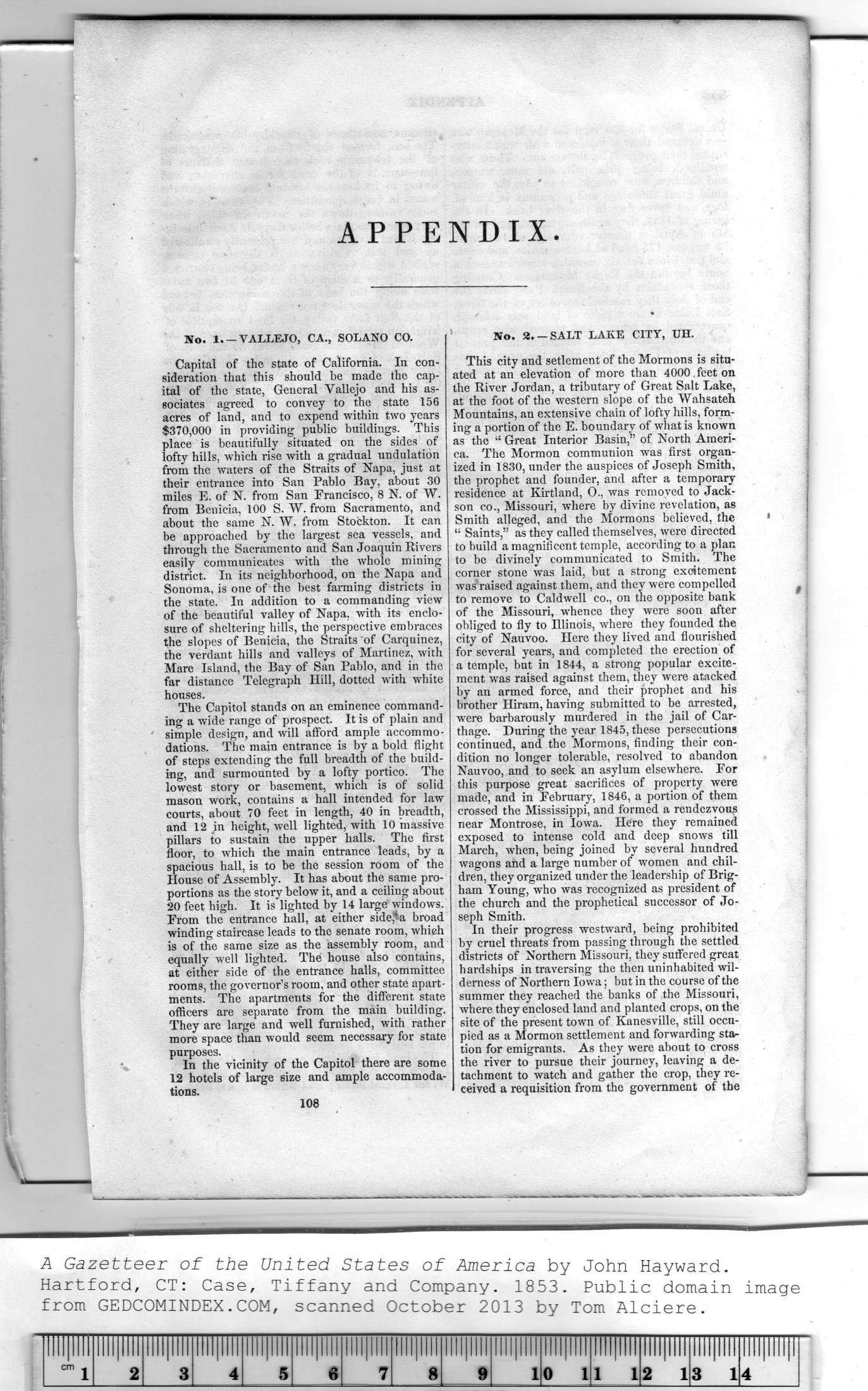|
No. 1.—VALLEJO, CA., SOLANO CO.
Capital of the state of California. In con-
sideration that this should be made the cap-
ital of the state, General Vallejo and his as-
sociates agreed to convey to the state 156
acres of land, and to expend within two years
$370,000 in providing public buildings. This
place is beautifully situated on the sides of
lofty hills, which rise with a gradual undulation
from the waters of the Straits of Napa, just at
their entrance into San Pablo Bay, about 30
miles E. of N. from San Francisco, 8 N. of W.
from Benicia, 100 S. W. from Sacramento, and
about the same N. W. from Stockton. It can
be approached by the largest sea vessels, and
through the Sacramento and San Joaquin Rivers
easily communicates with the whole mining
district. In its neighborhood, on the Napa and
Sonoma, is one of the best farming districts in
the state. In addition to a commanding view
of the beautiful valley of Napa, with its enclo-
sure of sheltering hills, the perspective embraces
the slopes of Benicia, the Straits 'of Carquinez,
the verdant hills and valleys of Martinez, with
Mare Island, the Bay of San Pablo, and in the
far distance Telegraph Hill, dotted with white
houses.
The Capitol stands on an eminence command-
ing a wide range of prospect. It is of plain and
simple design, and will afford ample accommo-
dations. The main entrance is by a bold flight
of steps extending the full breadth of the build-
ing, and surmounted by a lofty portico. The
lowest story or basement, which is of solid
mason work, contains a hall intended for law
courts, about 70 feet in length, 40 in breadth,
and 12 in height, well lighted, with 10 massive
pillars to sustain the upper halls. The first
floor, to which the main entrance leads, by a
spacious hall, is to be the session room of the
House of Assembly. It has about the same pro-
portions as the story below it, and a ceiling about
20 feet high. It is lighted by 14 large windows.
From the entrance hall, at either side,-'a broad
winding staircase leads to the senate room, whieh
is of the same size as the assembly room, and
equally well lighted. The house also contains,
at either side of the entrance halls, committee
rooms, the governor's room, and other state apart-
ments. The apartments for the different state
officers are separate from the main building.
They are large and well furnished, with rather
more space than would seem necessary for state
purposes.
In the vicinity of the Capitol there are some
12 hotels of large size and ample accommoda-
tions.
108
|
Illlplll |
lllllllll |
lllllllll |
lllllllll |
lllllllll |
lllllllll |
lllllllll |
lllllllll |
llll|llll |
lllllllll |
lllllllll |
lllllllll |
lllllllll |
lllllllll |
llll|llll|l| |
|
Gill j |
2 |
3 |
4 |
5 |
6 |
7 |
8 |
9 |
1 |
0 1 |
1 1 |
2 1 |
3 1 |
4 |
|
No. 2. — SALT LAKE CITY, UH.
This city and setlement of the Mormons is situ-
ated at an elevation of more than 4000 feet on
the River Jordan, a tributary of Great Salt Lake,
at the foot of the western slope of the Wahsateh
Mountains, an extensive chain of lofty hills, form-
ing a portion of the E. boundary of what is known
as the “ Great Interior Basin,'' of North Ameri-
ca. The Mormon communion was first organ-
ized in 1830, under the auspices of Joseph Smith,
the prophet and founder, and after a temporary
residence at Kirtland, O., was removed to Jack-
son co., Missouri, where by divine revelation, as
Smith alleged, and the Mormons believed, the
“ Saints,'' as they called themselves, were directed
to build a magnificent temple, according to a plan
to be divinely communicated to Smith. The
corner stone was laid, but a strong excitement
was raised against them, and they were compelled
to remove to Caldwell co., on the opposite bank
of the Missouri, whence they were soon after
obliged to fly to Hlinois, where they founded the
city of Nauvoo. Here they lived and flourished
for several years, and completed the erection of
a temple, but in 1844, a strong popular excite-
ment was raised against them, they were atacked
by an armed force, and their prophet and his
brother Hiram, having submitted to be arrested,
were barbarously murdered in the jail of Car-
thage. During the year 1845, these persecutions
continued, and the Mormons, finding their con-
dition no longer tolerable, resolved to abandon
Nauvoo, and to seek an asylum elsewhere. For
this purpose great sacrifices of property were
made, and in February, 1846, a portion of them
crossed the Mississippi, and formed a rendezvous
near Montrose, in Iowa. Here they remained
exposed to intense cold and deep snows till
March, when, being joined by several hundred
wagons and a large number of women and chil-
dren, they organized under the leadership of Brig-
ham Young, who was recognized as president of
the church and the prophetical successor of Jo-
seph Smith.
In their progress westward, being prohibited
by cruel threats from passing through the settled
districts of Northern Missouri, they suffered great
hardships in traversing the then uninhabited wil-
derness of Northern Iowa; but in the course of the
summer they reached the banks of the Missouri,
where they enclosed land and planted crops, on the
site of the present town of Kanesville, still occu-
pied as a Mormon settlement and forwarding star
tion for emigrants. As they were about to cross
the river to pursue their journey, leaving a de-
tachment to watch and gather the crop, they re-
ceived a requisition from the government of the |

